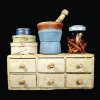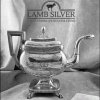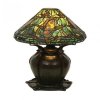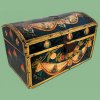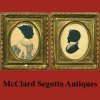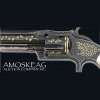The Baltimore Summer Antiques Show
October 27th, 2010
The Baltimore show filled the convention center for the 30th year. It has become far more elegant than it was for its first quarter-century. It has white carpets, spacious aisles, and wooden walls—not much pipe and drape. It is an upscale show, which pleased some dealers and made others nostalgic for the old days when Frank Farbenbloom ran the show and mom-and-pop dealers brought treasures with reasonable price tags.
Eve Stone of Woodbridge, Connecticut, offered English copper molds priced from $300 to $6500; the most expensive is the largest one, which is marked Fontainebleau. This was her first time exhibiting at the Baltimore show.
Richard Wagner of Wagner’s Weapons and Walking Sticks, Jaffrey, New Hampshire, holds a very tall cane used to get out of a stagecoach. It was $1195. “Most of these are cut down, so it is rare,” said Wagner.
John Atzbach of Redmond, Washington, asked $36,000 for this plate made at the Russian Imperial Porcelain Factory for Nicholas I to fill out his Coalport service, which was a gift from Queen Victoria. |
Baltimore, Maryland
by Lita Solis-Cohen
There were two entrances to the Baltimore Summer Antiques Show at the Baltimore Convention Center held on the four days before Labor Day, September 2-5. Over 500 dealers filled the vast 240,000-square-foot space with furniture, jewelry, paintings, sculpture, books, prints, posters, photographs, ephemera, handbags and hats, all sorts of collectibles, bronzes and ivory, and a variety of decorative arts, much of it Asian and some of it new. On Thursday before noon at the Pratt Street entrance, Kris Charamonde, Scott Diament, and Robert Samuels, the three young Florida jewelry dealers known as the Palm Beach Group, cut the ribbon marking the 30th anniversary of this show and its fifth year under their management.
Those who entered this show from the Charles Street entrance were greeted by a stand with a dozen very large photographs of notables: Mother Teresa, John F. Kennedy, Elvis Presley, Andy Warhol, Marilyn Monroe, and other instantly recognizable figures. Viewed up close, these large images were seen to be mosaics, made of tiny related images. For example, Andy Warhol is made of hundreds of tiny faces of Chairman Mao; Barack Obama's digital tesserae are images of Abraham Lincoln; and Brigitte Bardot's is made up of hundreds of tiny pictures of the Creation of Eve from Michelangelo's ceiling in the Sistine Chapel. Marilyn Monroe is composed of tiny images of the Mona Lisa, while Mother Teresa is a grid of Gandhi. The portraits come in two sizes: 40" x 60" (in editions of fewer than 20) for $7000 and 72" x 108" (in editions of fewer than ten) for $15,000.
They are the work of 40-year-old artist Alex Guofeng Cao, who came to New York City from China as a teenager and found his passion, photography, when he was studying at the Fashion Institute of Technology. Inspired by photographers Irving Penn, Richard Avedon, and Robert Mapplethorpe, Cao is primarily interested in the black-and-white images burned into our memory. Fascinated with the mosaics he discovered in Pompeii and Herculaneum, he created these portraits with digital photographic mosaics and printed them on large sheets of paper laid down on aluminum and covered by Plexiglas.
"I am trying to encode and layer information as it accumulates over time, the way history develops," said Cao. "I have set up a dialogue between the new digital technologies and photography's original analog techniques."
Cao's portraits suggest that he has looked at portraits painted by Chuck Close. Cao's most moving image is of the Pulitzer Prize-winning photograph by South African photographer Kevin Carter of a vulture waiting for a Sudanese child to die. That photo made Carter famous, but the hate letters he received accusing him of indifference to suffering helped push him to committing suicide two months after he won the prize. Cao's poster-size photo of Carter's prize-winning photograph is composed of tiny images of the man who took it. Cao said the irony is that the child in the picture lived. Cao's photographs were the talk of this show, which, like them, also presented two sides of a coin.
The Palm Beach Group has created an upscale, white-carpeted antiques show out of what for a quarter-century was the biggest indoor antiques market. Now its center aisles are filled with large stands where dealers present art and antiques in veritable galleries, while some parts of the show, for example the book and ephemera section and adjacent stands rented by generalists, are a reminder that this Baltimore show once was a pipe-and-drape, mom-and-pop show where some top dealers set up in order to buy. The sturdy walls and white carpet are a new look that makes the merchandise look even better.
While the old guard is nostalgic for the old days when mom-and-pop stands provided greater shopping opportunities, high booth rents, going higher, have priced the part-time, low-end dealers out of this show. "This is Palm Beach in Baltimore," complained one old-timer, but it isn't Palm Beach. The Palm Beach Jewelry, Art & Antique Show is the ultimate retail show with the highest gate.
Those who did not know the Baltimore show in the old days marveled at the elegance and enjoyed the ambiance and comfort of white-carpeted floors. Stands stocked by some top dealers with first-rate material replaced a group of equally prominent British and American dealers who did not return this year. Among the new dealers were Erik Thomsen, a New York City specialist in Japanese screens and lacquers, and Charles Plante, an American who lives in England but summers at Rehoboth, Delaware, and is known for small framed 19th-century watercolors, drawings, and small 20th-century sculpture. Plante's last show was at Mallett on Madison Avenue in New York City.
Russack & Loto Books from New Hampshire set up its stand in the antiques section, not in the book section, and offered books on European, Asian, and, their stock in trade, American decorative arts. For the first time, Maria Domont of Domont Jewelry, West Hollywood, came with costume jewelry. Jewelry, whether costume or real, is a large presence at this show, as are women's handbags. Three stands offered Chanel and Hermès handbags at four- and five-figure sums.
There were very few million-dollar items. M.S. Rau Antiques, New Orleans, brought a Monet oil painting depicting a flood at Giverny and asked $5.85 million for it. Michael Teller of TK Asian Antiquities asked $1.3 million for a 3rd-century Chinese gold vessel inlaid with turquoise and garnets; he said he sold it.
Dealers were the major buyers-dealers exhibiting and dealers who made the trip from New York and elsewhere, some from abroad. Other show promoters trolled the show trying to fill their upcoming shows, knowing that they could find 500 prospects in one place.
Even though dealers who set up stands got first dibs on buying from each other, some waited until the show opened before making their deals. Two days into the show Jim Alterman of Lambertville, New Jersey, bought Boca Raton, Florida, dealer Steve Newman's entire stand, most of it sculpture, including two Rodins. New York City dealer Greg Nanamura said his large silver-plated Italian cockatoo wine cooler was "bought on the floor." Just as the show opened, New Jersey dealer Marvin Baer was on his scooter heading for his stand with a large Imari charger in his arms. Half a dozen Chinese dealers with little on their stands were buying, mostly jades. Much Chinese was spoken on opening day as groups of young Chinese men moved from one stand to another.
Kris Charamonde said more decorators came to the show this year than last. Some were buying for clients in India and the Middle East and left with limousines and town cars full of packages. "When I saw a designer from Milan pushing three shopping carts I thanked him for coming," said Charamonde.
Some collectors found what they came for. Others, however, left empty-handed and said they were surprised that quality was not uniformly high at this non-vetted show of enormous variety.
Stephen W. Fisher, whose collection of Japanese cloisonné was shown at the Walters Art Museum earlier this year, bought what he called a masterpiece vase from Orientations Gallery, New York City. He said he spent $75,000 for it. Japanese cloisonné has been a specialty at Orientations for a generation.
Charamonde said he was amazed that business for some was remarkably good, given the state of the economy. "They may have not sold much in the six or seven figures, but a good many things in the fifty-thousand- to ninety-thousand-dollar range changed hands," he said.
Some dealers said they "pulled it out" on Sunday. Dealers who made multiple sales were happy to sign up for next year before they left. Some said doing OK in this market is considered good; they will be back. New York City print and map dealer W. Graham Arader took a small stand this year and put his son Walter in charge. Walter said it was not a good show for them, but Charamonde said Arader will take larger space next year and feature a collection of Maryland maps. The show attracts serious collectors from the U.S., Europe, and Asia.
There is probably more silver at the Baltimore show than at any other show in the U.S. Mount Kisco, New York, dealer Bill Drucker said he sold the first sugar muffineer made by Georg Jensen. It has a hand-hammered poppy motif and is marked number one. Mark McHugh and Spencer Gordon II of Spencer Marks, Southampton, Massachusetts, sold a silver Art Nouveau tea and coffee service by Orivit. A firm in Cologne, Germany that made silver from 1901 to 1905, Orivit was known for pewter and metalware sold at Liberty's in London.
Although several high-profile silver dealers did not return to the show this year, three silver dealers from Great Britain who in the past had come to shop took stands "for the optimum buying opportunity." Even though dealer-to-dealer business is a big part of this show, New York City silver dealer Robert Lloyd said he sold a pair of tall candlesticks made in London in 1764 to a new customer. "They saw my ad in the show catalog, wanted to come to my talk on Saturday afternoon but missed it, and came on Sunday. The best part is they are young collectors," he said. Lloyd had a good show; he also sold an English silver covered porringer from 1660 to a private client.
David Brooker, an Englishman who has a shop in Woodbury, Connecticut, and exhibits at the LAPADA show in Berkeley Square in London in September, said he sold 22 paintings at the Baltimore show last year and that this year he sold 14, most of them marine pictures. The show had a broad range of paintings, an enormous stock of prints, and some sculpture.
With a huge advertising blitz on TV and in the Baltimore and D.C. newspapers and an endless supply of free passes distributed by dealers (each dealer gets 50 passes), the management ensured a good gate. Dedicated collectors came back day after day. Some came from afar and stayed at the nearby hotels; others were day-trippers from D.C., Virginia, Delaware, and Pennsylvania. Thursday and Friday are known as trade days, Saturday and Sunday as retail. Every day was bargaining day.
"The consumers know they are in control," said Philadelphia paintings dealer Mark McCarty. "Collectors are making low offers, but they are coming back. I think we hit bottom, and business is on an upswing. There is a lot of interest. People are informed. I am optimistic." He sold six paintings.
On Thursday a contingent of dealers who had set up at Melvin Arion's York, Pennsylvania, antiques show on Wednesday came to shop, but they found little Americana mixed in with a lot of bronze sculptures and ivory carvings. Next year could be another story. The 2011 Baltimore show will be held a week earlier, August 25-28. The Original York Antiques Show & Sale is always held the Friday, Saturday, and Sunday before Labor Day.
"I have always wanted to avoid Labor Day when so many people have family conflicts, but we could never get the convention center the week before," said Charamonde. "On Labor Day weekend 2011, the Grand Prix auto race will be in Baltimore, so we got the convention center the weekend before. I hope that means a group of dealers with Americana will be part of this show."
Stay tuned by logging on to (www.collectorsartnet.com), a new social network site for dealers who participate in the Baltimore, Dallas, Fort Lauderdale, and Palm Beach shows, as well as for collectors and designers. "We want to create an international marketplace connecting dealers with their customers," said Scott Diament, the Palm Beach Group CEO in charge of this new venture. Dealers may post items in multiple views and link to their Web sites; collectors may post wish lists; and designers may post examples of their work. Membership is free for now. When the network is up and running successfully, there may be a small monthly membership fee.
For more information about the Baltimore show, call (561) 822-5440; Web site (www.baltimoresummerantiques.com).
Originally published in the November 2010 issue of Maine Antique Digest. (c) 2010 Maine Antique Digest






